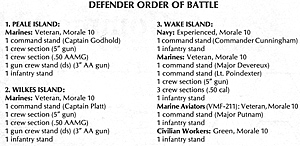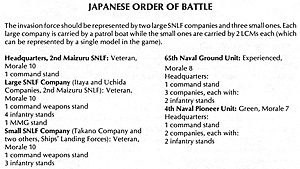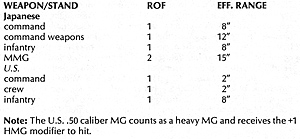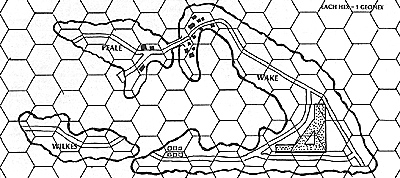BACKGROUND
Wake is a very small coral atoll formed from the rim of the crater of a submerged volcano. It is in the Central Pacific, roughly halfway along a line drawn from Midway to Truk (it is 1034 miles from the former and 1120 miles from the latter) and is at about the same latitude as the Hawaiian Islands. It consists of three actual islands: Peale, Wilkes, and wake. it is far too small to have native inhabitants, and was of no significance at all until it became a link in the Pan Am transoceanic airline route in 1935.
At that time Pan Am built a first-class hotel on Peale island as well as a seaplane dock and refueling facility. Attempts at well drilling yielded nothing but brine, and captured rainwater was the only source of drinking water. Native life on the island consisted solely of sparse vegetation, birds, and rats. Because of the excellent hotel, however, Wake became a welcome stop-over for trans-oceanic passengers and an important link in the Pacific air network. By the time of Pearl Harbor there were 70 Pan Am employees stationed on the island.
The military became interested in Wake in the late thirties as the threat of war loomed larger. A chain of aeronaval bases was planned across the Pacific and new Marine Defense Battalions formed to man them. The first construction workers landed on the island in January of 1941 and the first troops of the 1st Defense Battalion arrived in August. By December of 1941 the defenses were far from complete, but would nevertheless prove formidable during the battle. An airstrip was operational on Wake Island and twelve F4F Wildcats of VMF-211 were stationed there. In addition, three 5" coastal batteries (of two guns each) had been established on the three corners of the island.
THE BATTLE
The first phase of the battle lasted from December 8th through the 11th. The first Japanese air raid on the island caught eight of Wake's twelve F4F Wildcats on the ground and destroyed them. The remaining four aircraft remained active, however, and accounted for a respectable number of Japanese planes throughout the battle, as well as one destroyer. The Japanese invasion squadron closed on Wake on December lith. It consisted of the two old light cruisers of the CruDiv 18 (Tatsuta and Tenryo, actually large destroyers), one other old light cruiser (Yubari), the three destroyers of DesDiv 29 (Hayate, Oite, and Mutsuki), the three destroyers of DesDiv 30 (Kisaragi, Yayoi, Mochizuki), and two oceangoing patrol boats APD-32 and APD-33, and the two medium transports Kongo Maru and Konryo Maru. The transports carried 450 men of the Special Naval Landing Force drawn from a number of ships and bases.
The bombardment began at 0500 hours. An hour later the cruiser Yubari had closed to within about 5,000 yards of Peacock Point on Wake Island and Battery A opened fire. The Marine gunners hit Yubari almost immediately (0610). As the cruiser retired, one of the patrol boats made smoke, and was also hit by Battery A. Battery L on Wilkes island opened fire about an hour later and with its first salvo hit the destroyer Hayate, which immediately exploded and sank with all hands. Switching its fire, the battery then registered hits on the destroyer Oite, one of the two light cruisers of the CruDiv 18, and one of the transports. Battery B on Peale Island joined in and hit the destroyer Yayoi in the stern, after which it and the rest of DesDiv 30 made smoke and retired. By 0730 the surface action was over and the Japanese force had turned back to Kwajalein. VMF-211 sortied with its remaining four Wildcats and scored hits on the Tenryu, Tatsuta, Kongo Maru, and one patrol boat. Most impressive was the sinking of the destroyer Kisaragi by Captain Henry T. Elrod, the first major warship sunk by a fighter-dropped bomb in history.
The second phase consisted of renewed air attacks, which culminated in the eventual destruction of the last of VMF-211's Wildcats, and a second invasion attempt on December 23rd. The original invasion force had its damaged ships repaired and was considerably reinforced. Four more destroyers (Tusagaru, Asanagi, Yunagi, and Oboro) were added to the force as well as a minelayer, two transports, a floatplane tender and several submarines. The transports carried the 2nd Maizuru Special Naval Landing Force, a newly-arrived unit which brought the SNLF strength up to roughly 1,000 men.
The second invasion attempt was not preceded by a naval bombardment. Instead, the SNLF landing barges made a quiet approach in the pre-dawn darkness of December 23rd. A 100-man force (the "Takano" Company) hit the beach at Wilkes Island while the Itaya and Uchida Companies hit the southern shore of Wake Island. At 0500 Wake sent the famous message "Enemy on island. Issue in doubt." The actual first landing had been made at 0400 and by 0900 it seemed fairly clear that the situation was hopeless. About 1,000 Japanese were on the island, 27 ships were offshore, and the Japanese had control of the air. The surrender order went out, but it was about six more hours before the last fighting ended.
THE GAME
The second invasion of Wake Island makes a fairly interesting and balanced scenario. The odds are that the Japanese will win, but the numbers involved are not that overwhelming; the Japanese have an edge of about 2:1, while the defenders are superb troops on the defensive with a lot of firepower. The big Japanese advantage is the ability to pick a point and concentrate against it.
The game begins at 0400 and runs until 0900 (20 turns). At that time the referee may either decide that the defenders surrender or he may have them fight on. if they fight on, theJapanese Reserve may be committed. if they surrender, the referee decides whether they have inflicted sufficient casualties on the Japanese to have won a moral victory. The reserves may not be committed, however, so long as all three 5" gun positions are still manned and operational.
THE DEFENDERS
Total military manpower on the island was:
| UNIT | OFF. | EM. | TOTAL |
|---|---|---|---|
| 1st Marine Defense Bn. | 15 | 373 | 388 |
| VMF-211 | 12 | 49 | 61 |
| Naval Air Service | 10 | 58 | 68 |
| Army Air Corps | 1 | 5 | 6 |
| TOTAL | 38 | 485 | 523 |
1st Defense Battalion actually had only part of its strength on the island, with 388 men out of a total battalion strength of 952. The detachment was commanded by Major James P.S. Devereux and had all of the battalion's 5" 51 caliber coast defense guns (6) and 3" AA guns (12), as well as 24 of the battalion's 48 .50 caliber AA machineguns and about 20 of the battalion's 48 .30 caliber machineguns. Naturally this left the battalion extremely short of personnel. Priority was given to the big guns, and even though only ten of the 3" guns and 18 of the .50 calibers were still in service by the time of the invasion, most of the .30 caliber machinegun positions could not be manned on the 23rd.
At the time of the landing itself, only200 marines were available for beach defense, the rest being required to man the 3" and 5" gun batteries. However, the beach defenses were augmented with the 27 survivors of VMF-211 fighting as infantry as well as at least a dozen armed civilians. I assume the Naval Air Station personnel fought as infantry as well.
To represent the small garrison with a bit of panache, the following rule modifications are used:
1. 5" guns, .50 caliber AAMGs, and .30 caliber MMGs are manned by single-figure crew section stands. Any infantry stand can be broken into two single-figure crew sections; any two crew sections may be combined to form one infantry stand. Crew sections are treated like patrols in all respects except that they are not selfordering and when manning a crew-served weapon may fire it in any fire phase.
2. Only the three double-sized gun crew stands may man the3" AA guns. These crew stands may be converted to infantry stands or broken into crew sections if desired.
3. A single-figure command stand and a single-figure crew section may be combined to form a command infantry stand.
4. MMG and AAMG positions are fixed fortified positions. They are treated as a bunker for cover purposes. They may be occupied by two single figure stands or one full stand. The weapon may be manned by either a crew stand, a command stand, or a full infantry stand.
5. The civilian infantry stand may neither break down into crew sections nor man MG positions.
DEFENDER ORDER OF BATTLE

THE INVADERS
The actual landing force consisted of about 450 men of the "Ships' Landing Force", which was the SNLF group gathered for the original invasion attempt, and about 550 men of the 2nd Maizuru SNLF. The reserve force consisted of the 6th Base Force with another 500 men. This was the unit intended to garrison Wake after the invasion, but could have been used to beef up the assault troops. it consisted of the 65th Naval Ground Unit and the 4th Naval Pioneer Unit.
The troops were carried ashore by medium landing craft and two oceangoing patrol boats which were beached. Two medium landing craft carried the Takano Company to Wilkes island. Two more medium landing craft landed more troops south of Camp One. The patrol boat APD-33 beached south of the airfield and APD-32 beached between APD33 and the two medium landing craft to the west. Each patrol boat carried a full company of the 2nd Maizuro SNLF (the Uchida and Itaya Companies). There may have been two more medium landing craft which landed between APD-33 and Peacock Point.
JAPANESE ORDER OF BATTLE
The invasion force should be represented by two large SNLF companies and three small ones. Each large company is carried by a patrol boat while the small ones are carried by 2 LCMs each (which can be represented by a single model in the game).

WEAPON RATINGS FOR COMMAND DECISION
The 5" coastal defense guns were not able to fire on land targets and thus do not have any direct bearing on the land battle. The 3" AA guns are a different story. Although they were powerful and accurate guns, they were also massive beasts, weighing in at over8 tons in travel configuration (compare to 7 and a half for the German 88mm Flak 18). The could not be fired from their travel mounts and the massive cruciform firing platform made them impossible to manhandle. Treat them as a heavy gun for game purposes. They were technically a 76.21-50 gun. They fire with the same characteristics as the U.S. 76L52 with two exceptions. First, they have only HE ammunition. Second, the HE ammunition effectiveness is 1"/4, not 1"/3.
Small arms ratings for other troops are given below.

Note: The U.S. .50 caliber MG counts as a heavy MG and receives the +1 HMG modifier to hit.

Back to Table of Contents -- Courier Vol. VIII No. 2
To Courier List of Issues
To MagWeb Master Magazine List
© Copyright 1988 by The Courier Publishing Company.
This article appears in MagWeb (Magazine Web) on the Internet World Wide Web.
Other military history articles and gaming articles are available at http://www.magweb.com